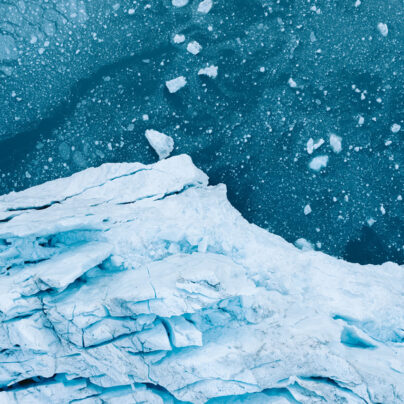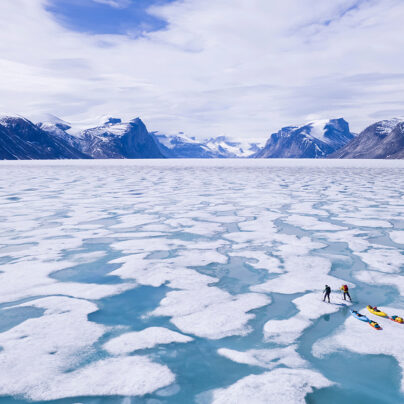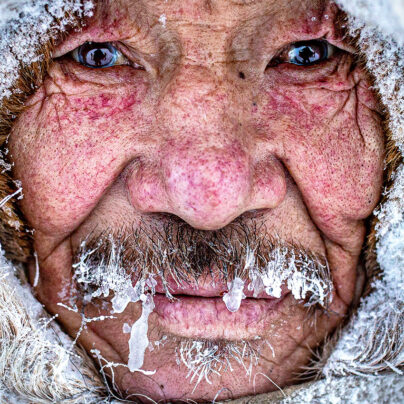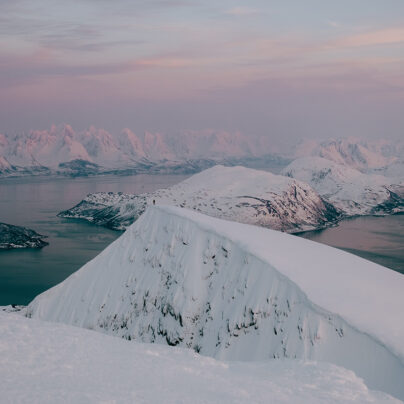Life Is All About Decisions
Alex Hibbert
I started out 2011 with the intention of taking on a major challenge on the icecaps, the places where I ply my trade. Rather, the place where I’d ply my trade week after week if funding and commitments in the ‘real world’ allowed. Having reunited with a great team mate from years past, Andrew Wilkinson, known as Wilki, we set out a plan to challenge our resolve, fitness and technical skill. Unlike my usual expeditions, which concentrate only on getting to the finish-line and not against the clock, we planned to do just that: ski an established route and try to go faster than anyone had previously. Our stage was the Greenland icecap and the Nagtivit Glacier to Point 660 route, which had over the years become the ‘standard’ traverse from east to west.
The target was an insanely quick eight days and nine hours to cross the 350 miles of glaciers and icecap, climbing from sea level to 8000ft and back down again. Set by Odd Harald Hauge and his ferociously experienced and talented Norwegian team in 2002, we had a hard task ahead of us. In the past, the accepted time for the best conditions, flat surfaces and therefore fastest speeds was late summer, August or September. A lot had changed between the earliest fast crossings in the 1990s and early 2000s and so I knew I’d need to take a fresh look at the situation and avoid following like a sheep. Melting on the coastal regions of the icecap had increased massively in that time, causing a great obstacle to fast travel with melt streams and pools blocking a skiers’ path.
With this in mind, and having climbed the Nagtivit Glacier twice in spring conditions and knowing it like the back of my hand, I suggested April. With Wilki in agreement, we set about preparing with the knowledge that thick snow and more unpredictable weather could limit our chances. To break the record, everything would need to be perfect, especially since the 45-mile ‘ice-road’ that the previous expeditions had enjoyed on the west coast no longer existed. In past years the emphasis had been on sustainability. This time, it had to be on sheer speed. Daily average distances would have to be over 40 miles; monstrous considering the elevation we’d need to climb with sledges in tow.
The target was an insanely quick eight days and nine hours to cross the 350 miles of glaciers and icecap, climbing from sea level to 8000ft and back down again.
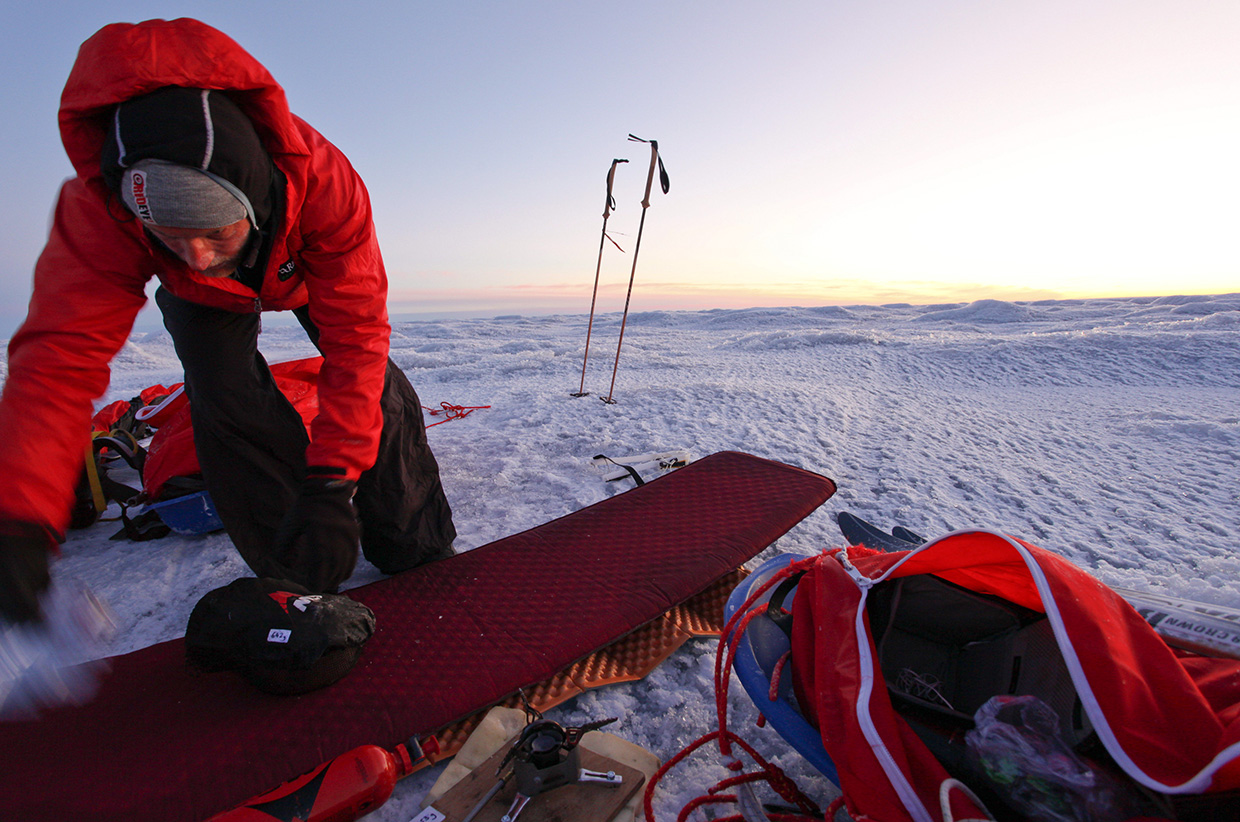

We were in for a long climb. Crevasse after crevasse was jumped or bridged, never allowing us to take a remotely straight path towards our goal.
One decision had been made, to try the crossing in April. I think it was the right one, avoiding the melt, but the unprecedented weather system had called an early end. That other decision, to postpone, had been made for us.
Undeterred and having made considerable investments in equipment and insurance, we regrouped for ‘take-two’, in the traditional speed season of late summer. Although I was concerned about the melting on the west coast, through the Russell Glacier icefall, it did make sense as a time to take on that target of less than nine days. There would be precious-little snow powder on the plateau and hopefully no sastrugi (hard-packed snow ridges) and I hoped, a little snow on the glacier slopes to fill in the crevasses and melt streams formed earlier in the summer. This was the theory but anyone with experience of wilderness locations knows that each year will bring with it a whole new box of challenges, many of them unexpected.
After a relatively stress-free few days of travel to Iceland, then Greenland and from one village to next, we made our way to Nagtivit by boat. The sea ice was light enough by August to allow a small boat through and so, avoiding a costly helicopter, our driver Lars took us through the icebergs and fog. A mile from our drop-off, a minke whale made an appearance and swam with us for a few minutes before plunging to the depths with a magnificent fluke of his huge tail. Soon after, the colossal ice cliffs of the glacier came into view, clearly totally dry i.e. without snow cover. We expected this for the lower, warmer slopes but hoped that before long, snow cover would smooth out the bumps and crevasse openings. Our hopes were in vain. After testing our shotgun (for bear protection) and following nearly 24 hours’ hard work through the maze of gulleys, crevasses and ridges, it was clear that the snowline was well above 1000m. We were in for a long climb. Crevasse after crevasse was jumped or bridged, never allowing us to take a remotely straight path towards our goal. I even managed to fall, unroped, up to my elbows through a crevasse-spanning bridge. Unable to move without falling through into the 100-foot deep chasm, I awaited a rope from Wilki so I could clamber out.


Knowing deep down that our record chances were slim, we nevertheless skied like dervishes towards the west. We skied 13-16 hours per day, slept for three or four hours and on four occasions did not even erect the tent at night, instead open-air bivi’ing in the cold darkness.
Having had precious little sleep for days and legs that already had nearly three hundred miles put through them, the descent was torture of the mind and the body. Melt pools; melt rivers thirty foot wide and three feet deep with strong currents. Crevasse fields twenty miles long and with five to fifteen foot-wide crevasses set at twenty-foot intervals. They had no snow bridges to allow us to cross and so instead, we had to leap across the more feasible gaps just to gain a few metres. Eventually, Wilki and I had spotted the area of land we were aiming for and from a high point of ice, viewed the route down over the remaining miles.
We had come to our final crux – the point where we needed to make a call. This time, it was a balance between our pride and our survival. The ground ahead looked even worse. Every crevasse we jumped involved a leap of faith and then a desperate sprint up the far side to try and stop the sledges plunging down and inverting, making the process of hauling them out even harder. Instead of forty miles per day, we were down to one hundred yards per hour. The record gone and having skied a very fast and satisfying 330 miles in less than twelve days (most crossings take 22-30 days), we decided in the interests of self-preservation to move our helicopter pickup to our current location. With a great deal of scheduling luck and hard-work from our home-team and the charter company, a Eurocopter arrived three hours later. As we lifted off and flew over the remaining ice, we stared open-mouthed. We had made the right call – it was impassable.

Alex is a world-record holding polar expedition leader. Only twenty-seven years old, he has spent over one hundred and sixty-five days unsupported in the Arctic and has crossed the second largest icecap on Earth four times. In 2008 he completed the longest unsupported Arctic journey in history (at the time, the longest polar journey).
He is also the author of three books, The Long Haul, Kalaallit Nunaat and Maybe, and is a globally published photographer. He is currently planning The Dark Ice Project, a 210 day expedition, beginning in the darkness of polar winter.
For more information, visit his website or follow him on Twitter @alexhibbert


